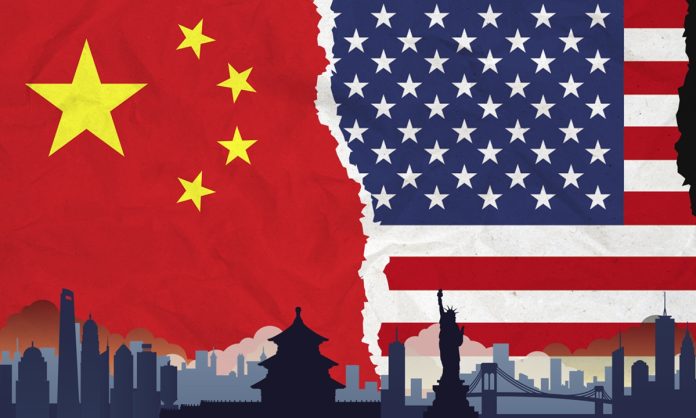The United States and China are once again at a crossroads in their trade relationship. President Donald Trump’s recent decision to impose sweeping tariffs on Chinese imports has triggered a strong response from Beijing, with the Chinese government urging an immediate reversal and warning of retaliatory measures. As global markets brace for the fallout, the escalating trade tensions raise concerns about economic stability, supply chain disruptions, and the broader geopolitical landscape.
In This Article:
The New Tariffs and China’s Response
In a move reminiscent of his first term, Trump announced a 34% tariff on Chinese goods, in addition to the 20% levy previously imposed this year. This brings the total tariff burden on Chinese imports to 54%, edging closer to the 60% mark he had promised during his campaign. The measures also include a baseline 10% tariff on almost all goods imported into the U.S., affecting global trade partners like Vietnam, India, Mexico, and Malaysia, which have been key beneficiaries of supply chain diversification.
China’s Commerce Ministry swiftly condemned the move, arguing that it disregards years of multilateral trade negotiations and the mutual benefits derived from globalization. A spokesperson for the ministry stated, “China firmly opposes this and will take countermeasures to safeguard its own rights and interests.” This signals a high likelihood of retaliatory tariffs on U.S. goods and potential economic sanctions.
Implications for Global Trade and Markets
With China and the U.S. locked in a tit-for-tat economic battle, global markets have reacted with volatility. Investors are concerned that the trade war could lead to:
- Increased costs for businesses and consumers: Tariffs act as a hidden tax, making imported goods more expensive and driving up inflation.
- Supply chain disruptions: Many companies have spent years adjusting their supply chains to mitigate previous trade conflicts. However, with new tariffs affecting Vietnam, Mexico, and India, alternative trade routes are also becoming costly.
- Uncertain business investments: Companies are hesitant to make long-term investment decisions due to policy unpredictability and economic instability.
China’s Countermeasures: What Comes Next?
China has several strategic options to counter Trump’s tariffs:
- Retaliatory Tariffs: Beijing could impose heavy duties on key U.S. exports, such as soybeans, aircraft, and semiconductor products.
- Restricting Rare Earth Exports: The U.S. heavily relies on China for rare earth minerals, crucial for tech manufacturing. A restriction could disrupt industries from electronics to defense.
- Boosting Trade with Other Markets: While the U.S. remains a dominant consumer market, China is actively expanding trade with Europe, Southeast Asia, and Africa to reduce dependency on American buyers.
- Devaluing the Yuan: A weaker Chinese currency would make exports more competitive, offsetting some of the tariff impacts.
- Regulatory Barriers for U.S. Companies: American corporations operating in China, such as Tesla, Apple, and Starbucks, could face increased scrutiny, compliance challenges, or even restrictions.
Why These Tariffs Matter
Trump’s decision marks a major shift in U.S. trade policy. During his first presidency, he initiated the Phase 1 U.S.-China Trade Agreement, which required China to purchase $200 billion in additional U.S. exports over two years. However, the COVID-19 pandemic disrupted these commitments, leading to unmet targets.
Now, with a fresh wave of tariffs, analysts believe the strategy could backfire on the U.S. economy. American importers, manufacturers, and consumers bear the brunt of tariff costs, leading to price hikes on electronics, automobiles, clothing, and essential goods.
Moreover, major U.S. corporations have long relied on Chinese manufacturing. The “China+1” strategy, where companies shift production to places like Vietnam, India, and Mexico, is now in jeopardy due to Trump’s global tariff approach. If businesses cannot find cost-effective alternatives, they may return manufacturing to China despite the tariffs, creating an ironic outcome.
What’s at Stake for the Global Economy?
- A potential slowdown in global economic growth if trade restrictions persist.
- Strained diplomatic relations between the world’s two largest economies.
- Higher consumer prices worldwide, particularly in the U.S., where Chinese imports contribute significantly to affordability.
- Shifting trade alliances, as countries seek stability outside of U.S.-China conflicts.
Can Negotiations Prevent a Full-Scale Trade War?
There is speculation that Chinese President Xi Jinping and Donald Trump may meet in June, offering a diplomatic avenue to de-escalate tensions. Experts believe China has been strategically reserving economic stimulus measures to counteract the effects of a prolonged trade war. This includes monetary easing, increased domestic consumption, and fiscal stimulus.
However, both leaders face political challenges. Trump’s maximum-pressure tactics are aimed at securing better trade deals, but he risks economic blowback before the U.S. presidential election. Meanwhile, Xi Jinping must balance national pride with economic pragmatism, ensuring China does not appear weak while safeguarding economic stability.
As China vows retaliation against Trump’s latest tariffs, the world is watching closely. The escalating trade war could reshape global supply chains, market trends, and economic policies in the years ahead. While China has prepared for this moment with diversified trade strategies, the economic standoff remains a high-stakes gamble. Whether the two superpowers find common ground or continue down this confrontational path will determine the future of global trade and economic stability.
By – Jyothi




